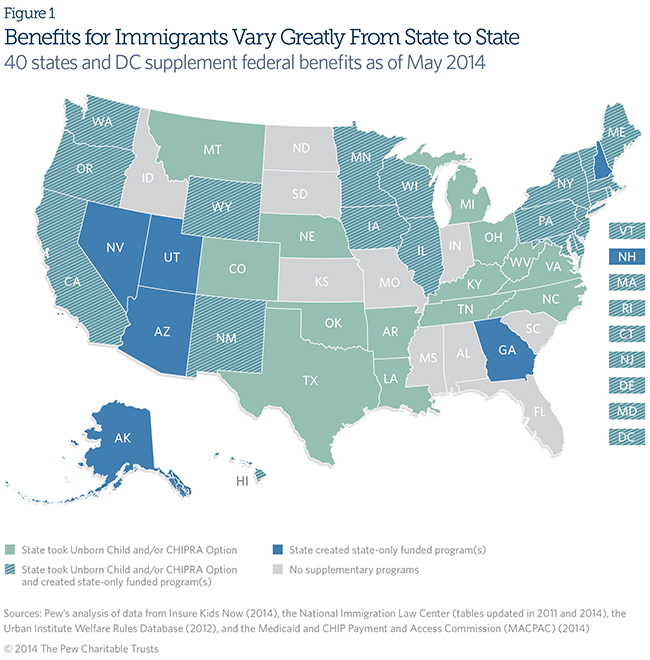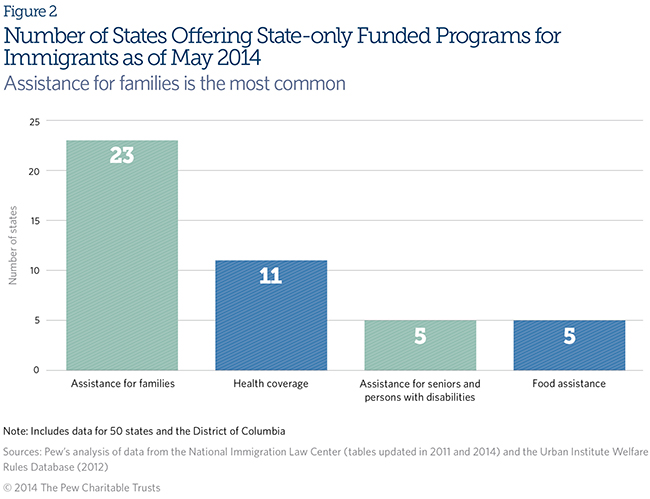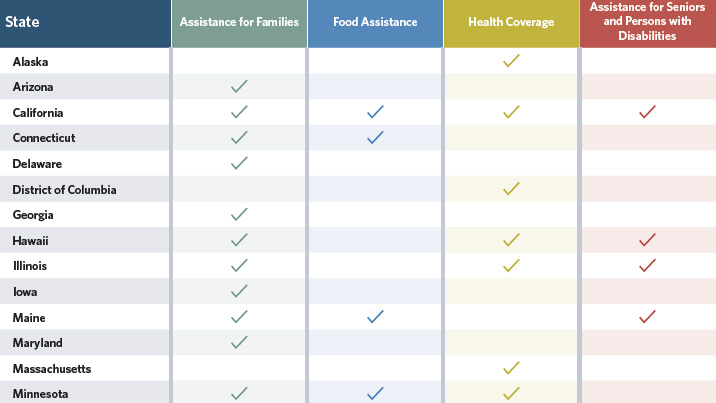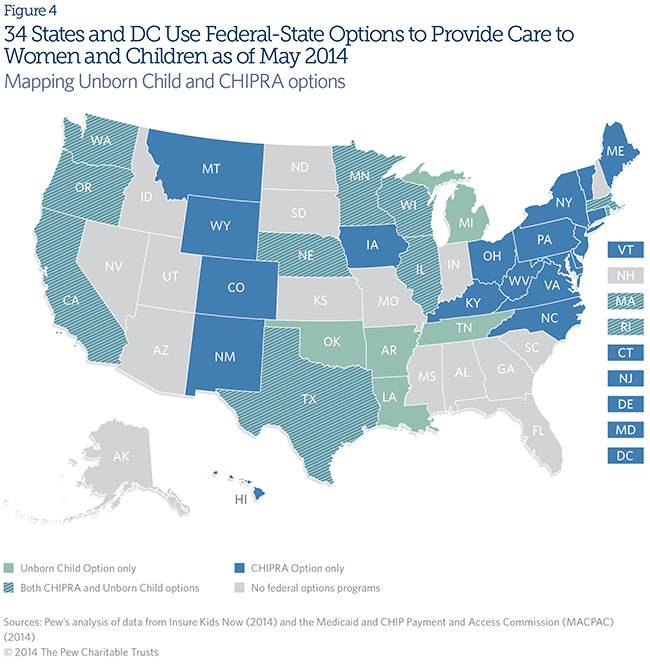Mapping Public Benefits for Immigrants in the States
Overview
The federal government and the states play critical roles in providing public benefits to immigrants. In some cases, those who meet all eligibility requirements can receive assistance through federal public benefits programs. States also manage an array of programs that may be available to certain immigrants.
This brief focuses on five major means-tested public benefits programs—nonemergency Medicaid, the Children’s Health Insurance Program, Temporary Assistance for Needy Families, the Supplemental Nutrition Assistance Program, and Supplemental Security Income—each of which has its own rules for determining eligibility and benefits. The 1996 Personal Responsibility and Work Opportunity Reconciliation Act, commonly known as welfare reform, restricted federal benefits for many legal immigrants. That shift left states with the option to fill the gap and provide state-funded benefits programs for legal immigrants who became ineligible for federal programs.
Various approaches to providing assistance to immigrants have created a complex landscape in which the benefits available differ from state to state. In recent years, states have legislated a number of immigrant health and benefits issues. Some examples of these include introducing citizenship requirements for health care and public benefit eligibility and taking additional steps to further ensure that only those eligible are granted benefits.1 States are likely to continue to explore this area and make decisions that affect immigrant communities, as well as state budgets and economies.
The following maps and analyses highlight the layers of federal and state government programs involved in providing public benefits to immigrants, and explore the choices that states have made in response to options in federal law. This report is not meant to be an exhaustive list of benefits and programs available to immigrants. Furthermore, though the brief points out the existence of such programs across the country, it does not speak to their specific scope or eligibility requirements. Wide variation exists across the states in terms of who is eligible and how the programs are administered.
This brief is intended to inform policymakers about the role different levels of government play in providing certain public benefits to immigrants. The Pew Charitable Trusts takes no position on federal, state, or local immigration-related laws or policies.
Welfare reform changed immigrant eligibility for federal public benefits
The federal government has five major means-tested public benefits programs:
- Medicaid provides free or low-cost medical coverage to low-income families that meet economic and other eligibility requirements.2
- Children’s Health Insurance Program (CHIP) provides free or low-cost medical coverage to children in low-income families that exceed Medicaid income requirements.3
- Temporary Assistance for Needy Families (TANF) is a program for low-income families with children, which offers cash assistance as well as other services such as vocational training and job placement for unemployed parents. TANF replaced the Aid to Families with Dependent Children program in 1996.4
- Supplemental Nutrition Assistance Program (SNAP), previously called the Food Stamp program,5 provides low-income individuals and families with assistance to purchase food.
- Supplemental Security Income (SSI) is a federal cash assistance program that supports low-income seniors and people who are blind or have disabilities.6
These programs are provided in all states except Arizona, where CHIP was recently terminated.7 SNAP and SSI are fully funded by the federal government, while Medicaid, CHIP, and TANF require states to furnish a portion of the funding.
The Personal Responsibility and Work Opportunity Reconciliation Act of 1996, the welfare reform law, limited access to federal public benefits programs for legal immigrants. It left states with crucial roles in shaping the benefits delivery system, giving them the authority to establish—for certain legal immigrants—state-funded programs to replace federal benefits, and to set requirements for TANF and Medicaid eligibility for other specified immigrants.8
Welfare reform created two categories of immigrants:
- “Qualified” immigrants include lawful permanent residents (green card holders), humanitarian immigrants (such as refugees and those granted asylum), and several other categories of legal immigrants.9
- Noncitizens who do not meet these criteria are considered “not qualified” immigrants. They include some temporary workers, students and tourists, people granted temporary protected status, and unauthorized immigrants.10
In addition to creating two categories, welfare reform instituted a five-year waiting period, meaning most qualified immigrants will be eligible to apply for means-tested benefits only after they have been in the United States for five or more years as a “qualified” immigrant. Humanitarian immigrants and veterans or members of the military are exempt from this waiting period. All qualified immigrants, just like U.S. citizens, are subject to other eligibility requirements for federal programs, such as income level, family composition, and work history, depending on the program. Unauthorized immigrants have historically been ineligible for most federal public benefits programs.
Immigrants and Heath Care Reform
The Affordable Care Act (ACA), enacted in 2010, made many changes to the U.S. health care system. The law requires most individuals to have health insurance or face tax penalties. It created health insurance exchanges where individuals and families can purchase health insurance policies, and it provides subsidies to certain individuals and families to purchase insurance. The ACA also expanded eligibility for the Medicaid program. However, the immigration-related eligibility requirements for Medicaid did not change.
“Lawfully present” immigrants—a category that includes “qualified” immigrants as well as certain other immigrants who have permission to live in the U.S.11—are subject to the mandate to have health insurance or pay a penalty. They may purchase insurance on exchanges—the online marketplaces for health insurance—and may qualify for tax credits or cost-sharing subsidies.12 Unauthorized immigrants are not subject to the mandate, cannot purchase insurance on the exchanges, and do not qualify for related tax credits or subsidies.
States cannot exempt lawfully present immigrants from the mandate or the tax penalties, change the eligibility requirements for tax credits or subsidies, or deny them the ability to purchase insurance on the exchange. States may be able to create their own supplemental state exchanges where unauthorized immigrants can purchase health insurance, separate and apart from the system governed by the ACA.13
New roles for the states: Programs funded only by states
Welfare reform, while defining which immigrants qualified for means-tested benefits and when, also allowed states to establish their own programs, using their own funds, to expand benefits more broadly.14 Many states created new programs to extend coverage to immigrants ineligible for federal public benefits. Such programs included those for qualified legal immigrants during the five-year waiting period. Other states created programs they funded themselves or expanded existing programs to include immigrants ineligible for federal aid.15 Unlike the five major federal benefits programs that are either fully or partially funded by the federal government, these state specific programs are funded only by state dollars with eligibility determined by each individual state.
New federal-state options
After enactment of the welfare reform law in 1996, the federal government continued to modify the eligibility requirements for certain programs. For example, the Farm Security and Rural Investment Act extended SNAP eligibility in 2002 to qualified immigrant children without a waiting period.16 In 2002 and 2009, states also were granted options for expanding health coverage to certain immigrants using Medicaid and CHIP, which are jointly funded by states and the federal government. These include two major federal-state health care options:
- The Unborn Child Option (sometimes referred to as the “Fetus” Option) was added to CHIP in 2002 when regulations were modified to include fetuses under the definition of children. This change effectively allowed states to use federal CHIP funding to provide prenatal care to pregnant women, regardless of their status.17
- The CHIPRA Option was added in 2009 as an amendment to the Children’s Health Insurance Program Reauthorization Act (CHIPRA) to allow states to provide medical coverage through Medicaid and CHIP to lawfully present18 pregnant women and children, without a waiting period.19 As part of the CHIPRA Option, the federal government offered states an enhanced federal match rate for all children under age 19.20
Most states provide supplemental benefits to immigrants
Forty states and the District of Columbia either supplement federal benefits programs with programs funded only by the states, or take the Unborn Child or CHIPRA options that expand the federal programs with state and federal matching funds. Twenty states and the District have created or expanded state-only funded programs and taken at least one of the options. Only 10 states have neither provided their own programs for immigrants nor taken up one of the federal-state options to expand eligibility. The appendix provides additional information regarding which states have created state-only funded programs and taken federal-state options for immigrants.
State-funded programs vary considerably in regard to their eligibility requirements, which immigrants they serve, and what benefits immigrants can receive. For example, some states may extend state-funded benefits to all immigrants ineligible for federal assistance, while others make them available to smaller, specific groups of immigrants.
States that elect to take the federal Unborn Child and CHIPRA options also vary in terms of which immigrants are eligible for these benefits. Figure 1 shows which states provide some sort of supplemental benefits by either taking the federal Unborn Child21 or CHIPRA22 options or providing benefits with state funding to some immigrants ineligible for the major federal programs.
The Systematic Alien Verification for Entitlements Program
State and local benefit-granting agencies can - and in some cases must - verify an immigrant’s status and eligibility for public benefits with the Systematic Alien Verification for Entitlements (SAVE) program.23 SAVE is an online system operated by U.S. Citizenship and Immigration Services to verify that immigration information and documentation presented when applying for benefits match federal immigration records.
Government agencies submit information electronically to the SAVE system, which either confirms the applicant’s immigration status or asks for more details before making a final determination. SAVE does not indicate whether the individual is eligible for a benefit. It simply verifies that the immigration status matches the documentation presented to the benefit-granting agency. The agency then makes the final determination as to whether the immigrant meets all eligibility criteria for the benefit sought.
Federal, state, and local government agencies may use SAVE if the agency “provides a public benefit or license, or is otherwise allowed by law to engage in an activity where the verification of immigration status is appropriate.” Government agencies must apply to U.S. Citizenship and Immigration Services to employ SAVE and must sign a Memorandum of Understanding with the agency.24 Private companies and individuals cannot use SAVE. Government agencies must pay a transaction fee; the initial amount is 50 cents per electronic query or $2 if a paper form is submitted.25

State-only funded programs for immigrants
Twenty-six states and the District supplement federal benefits programs with state-only funded programs for immigrants, as indicated by blue and cross-hatching in Figure 1.26 The remaining 24 states do not supplement federal benefits programs with state-only funded programs (indicated by green and gray in Figure 1). Of the jurisdictions with such programs, TANF replacement programs that provide help to low-income families are the most widely available; 23 states offer that benefit.27 Ten states and the District offer some kind of health benefits, the next largest category. (See Figure 2.)28 The various combinations of state-only funded assistance for families, health coverage, food assistance, and assistance for seniors and persons with disabilities29 offered in 26 states and the District are shown in Figure 3.
Examples of state-funded assistance for families and food assistance programs are detailed below:
- New York’s Safety Net Assistance program provides cash assistance to qualified immigrants who are experiencing financial hardship but are ineligible for TANF because of the five-year bar, as well as other lawfully present immigrants.30 For example, during temporary periods of unemployment, the program provides cash assistance to families for up to two years. Beyond that time, noncash benefits, such as vouchers or two-party checks, are available.31
- California’s CalFresh Food Assistance Program provides nutrition assistance equivalent to SNAP to qualified immigrants and those who are survivors of certain crimes.32
- Under California’s Cash Assistance Program for Immigrants, low-income seniors and people with disabilities who are either qualified immigrants or meet certain other requirements may be eligible to receive assistance without a waiting period.33
State-only funded programs for health coverage vary a great deal in terms of eligibility and types of services provided. Alaska’s supplemental health coverage is limited to individuals with specific conditions such as cancer and seizure disorders, while health coverage for immigrants in Massachusetts, on the other hand, extends to all children regardless of immigration status.34 Other state-funded health programs include the following.
- Illinois’ All Kids program offers reduced-cost health insurance coverage to children in low-income families regardless of immigration status or preexisting health conditions. Currently more than 1.6 million children are enrolled in the program, which covers doctor’s visits, prescription drugs, and hospital stays, as well as dental and vision care. Premiums in the All Kids program depend on a family’s income; some families qualify for free coverage.35
- MinnesotaCare provides state-only funded medical insurance for adults to replace benefits lost as a result of the 1996 welfare reform law. Qualified immigrants who are not yet eligible for federal Medicaid because of the five-year waiting period and other lawfully present immigrants are eligible for coverage.36 Premiums are based on a sliding scale, taking into account family size and income. Some individuals are exempt from premiums, including children under age 21, some military families, and families in which at least one member is American Indian.37

CHIP and CHIPRA federal-state options for immigrants

Thirty-four states and the District have elected to take one or both of the Unborn Child or CHIPRA options. Health coverage can be offered through the CHIP program’s Unborn Child Option or the CHIPRA Option for lawfully present pregnant women and children. Ten states have taken both options, five participate in only the Unborn Child Option,38 and 19 states and the District participate in only the CHIPRA Option. (See Figure 4.)39
States that have chosen these options can also implement the programs in different ways. Under the CHIPRA Option, states can decide whether to cover pregnant women, children, or both, and can also select whether to fund this coverage through Medicaid or both Medicaid and CHIP. For example, the CHIPRA Option in Massachusetts uses CHIP funds to cover children, and it draws on Medicaid to cover both pregnant women and children. The CHIPRA Option in Colorado, on the other hand, uses only Medicaid funds to cover pregnant women.40

Conclusion
The delivery structure of public benefits programs is not only complicated at the federal level, but many states have also chosen to expand access to federal benefits or to provide state-only funded benefits to some immigrants ineligible for federal assistance. This web of programs with varying eligibility rules illustrates the overlapping roles of the federal government and the states in providing services for the nation’s immigrants. Although the federal government maintains authority over admitting immigrants into the country and their eligibility for federal benefits programs, states have choices in making certain benefits available to their immigrant residents. The conversation about immigrant eligibility for a wide range of federal, state, and local public benefits is likely to continue across the United States. Policymakers need to be aware of the complexities in the parts each level of government can play in designing programs for immigrants and take these into consideration when making decisions about public benefits.
Endnotes
- Ann Morse, “2013 Immigration Report,” National Conference of State Legislatures (Jan. 20, 2014), http://www.ncsl.org/research/ immigration/2013-immigration-report.aspx#2.
- Medicaid.gov, “Medicaid Eligibility,” http://www.medicaid.gov/Medicaid-CHIP-Program-Information/By-Topics/Eligibility/Eligibility.html, and “2014 Federal Poverty Guidelines,” http://bit.ly/1oCaFgc.
- Title IV of the Balanced Budget Act of 1997, Public Law 105-33.
- Government Accountability Office, “Welfare Reform: Projected Effects of Requiring AFDC for Unemployed Parents Nationwide” (May 1988), http://www.gao.gov/assets/80/77074.pdf.
- Gene Falk and Randy Alison Aussenberg, “The Supplemental Nutrition Assistance Program (SNAP): Categorical Eligibility,” Congressional Research Service (July 22, 2014), http://www.fas.org/sgp/crs/misc/R42054.pdf.
- Uma Moulta-Ali, “Supplemental Security Income (SSI): Income/Resource Limits and Accounts Exempt From Benefit Determinations,” Congressional Research Service (Jan. 25, 2013), https://www.fas.org/sgp/crs/misc/RS20294.pdf.
- Tricia Brooks, Martha Heberlein, and Joseph Fu, “Dismantling CHIP in Arizona: How Losing KidsCare Impacts a Child’s Health Care Costs,” Georgetown University Health Policy Institute (May 2014), http://ccf.georgetown.edu/wp-content/uploads/2014/05/Dismantling-CHIP-in-Arizona.pdf.
- Karina Fortuny and Ajay Chaudry, “A Comprehensive Review of Immigrant Access to Health and Human Services,” The Urban Institute, (June 2011), http://www.urban.org/UploadedPDF/412425-Immigrant-Access-to-Health-and-Human-Services.pdf.
- Fortuny and Chaudry, “A Comprehensive Review,” vii.
- Ibid.
- National Immigration Law Center, “ ’Lawfully Present’ Individuals Eligible Under the Affordable Care Act” (September 2012), http://www.nilc.org/document.html?id=809.
- National Immigration Law Center, “A Quick Guide to Immigrant Eligibility for ACA and Key Federal Means-tested Programs” (Jan. 29, 2013), http://www.nilc.org/access-to-bens.html.
- California is considering setting up its own health care exchange: CA SB 1005, introduced Feb. 13, 2014, http://www.leginfo.ca.gov/pub/13-14/bill/sen/sb_1001-1050/sb_1005_bill_20140213_introduced.html.
- Fortuny and Chaudry, “A Comprehensive Review,” 4–5.
- Fortuny and Chaudry, “A Comprehensive Review,” 5.
- Fortuny and Chaudry, “A Comprehensive Review,” 4.
- The Kaiser Commission on Medicaid and the Uninsured, “New Option for States to Provide Federally Funded Medicaid and CHIP Coverage to Additional Immigrant Children and Pregnant Women” (Washington, D.C.: Kaiser Family Foundation, 2009), http://kff.org/medicaid/fact-sheet/new-option-for-states-to-provide-federally/
- The term used in the CHIPRA regulations is “lawfully residing.” Lawfully residing immigrants are “lawfully present” and meet state residency requirements. See Centers for Medicare & Medicaid Services, ”Re: Medicaid and CHIP Coverage of ‘Lawfully Residing’ Children and Pregnant Women” (July 1, 2010), http://downloads.cms.gov/cmsgov/archived-downloads/SMDL/downloads/SHO10006.pdf.
- Ibid.
- Claims paid on behalf of children as part of CHIPRA may be matched at the enhanced Title XXI match rate, regardless of whether the child is covered through Medicaid or a CHIP program. States may also claim regular Medicaid Federal Financial Participation for children enrolled in Medicaid or CHIP as part of the CHIPRA option. See Centers for Medicare & Medicaid Services, “Re: Medicaid and CHIP Coverage.”
- Medicaid and CHIP Access Commission, “Report to the Congress on Medicaid and Chip” (March 2014), 80–81, Table 9: Medicaid and CHIP Income Eligibility Levels as a Percentage of the Federal Poverty Level for Children and Pregnant Women by State, http://www.macpac.gov/reports.
- InsureKidsNow.gov, “Medicaid and CHIP Coverage of Lawfully Residing Children and Pregnant Women” (updated March 24, 2014), http://www.insurekidsnow.gov/professionals/eligibility/lawfully_residing.html.
- U.S. Citizenship and Immigration Services, “What Is SAVE?” http://www.uscis.gov/save/what-save/what-save. The REAL ID Act of 2005, Public Law No. 104-193, mandates that states enter into agreements with the Department of Homeland Security (DHS) to routinely use SAVE to verify the status of applicants for driver’s licenses or identification cards in order for such documents to be considered REAL ID compliant. The Patient Protection and Affordable Care Act of 2010, Public Law No. 111-148, requires the Secretary of Health and Human Services (HHS) to submit health insurance benefit applicants’ information to DHS to verify immigration status if certain conditions apply. Agencies administering TANF, Medicaid, unemployment compensation, some education programs, and some housing programs must also use SAVE. Finally, a number of states have enacted legislation requiring immigration status verification before issuing state-administered benefits and licenses.
- U.S. Citizenship and Immigration Services, “Sign Up for the SAVE Program,” http://www.uscis.gov/save/getting-started/signup-save-program.
- U.S. Citizenship and Immigration Services, “SAVE Access Methods and Transaction Charges,” http://www.uscis.gov/save/getting-started/save-access-methods-transaction-charges.
- Does not include state programs that did not cover new classes of immigrants after the welfare reform law but covered only individuals who had been eligible for benefits before its enactment.
- David Kassabian et al., Welfare Rules Databook: State TANF Policies as of July 2012, OPRE Report 2013-27 (November 2013), 56, Table I.B.6: States Using State Funds to Help Noncitizens Who Entered After Enactment and Are Ineligible for Federal TANF Assistance, July 2012, http://bit.ly/1nG211W.
- Tanya Broder, “Medical Assistance Programs for Immigrants in Various States,” National Immigration Law Center (February 2014), http://www.nilc.org/health.html.
- National Immigration Law Center, “Guide to Immigrant Eligibility for Federal Programs” (March 2011), Table 9: State-funded SSI Replacement Programs, and Table 12: State-funded Food Assistance Programs (March 2014), http://www.nilc.org/guideupdate.html.
- National Immigration Law Center, “Guide to Immigrant Eligibility for Federal Programs” (August 2011), Table 8: State-funded TANF Replacement Programs, http://www.nilc.org/guide_tanf.html.
- New York State Office of Temporary and Disability Assistance, “Temporary Assistance” (2014), http://otda.ny.gov/programs/temporary-assistance/.
- National Immigration Law Center, “Guide to Immigrant Eligibility for Federal Programs” (March 2014), Table 12: State-funded Food Assistance Programs, http://www.nilc.org/guideupdate.html.
- California Department of Social Services, “Cash Assistance Program for Immigrants (CAPI),” accessed September 2, 2014, http://www.cdss.ca.gov/cdssweb/Pg42.htm.
- Tanya Broder, “Medical Assistance Programs.”
- State of Illinois, “All Kids: Healthcare for All Kids” (2014), http://www.allkids.com/hfs8269.html.
- Tanya Broder, “Medical Assistance Programs.”
- Minnesota Department of Human Services, “MinnesotaCare” (updated Dec. 24, 2013), http://www.dhs.state.mn.us/main/idcplg?IdcService=GET_DYNAMIC_CONVERSION& RevisionSelectionMethod=LatestReleased& dDocName=id_006255.
- Medicaid and CHIP Access Commission, “Report to the Congress.”
- InsureKidsNow.gov, “Medicaid and CHIP Coverage.”
- Ibid.
This brief is intended to inform policymakers about the role different levels of government play in providing certain public benefits to immigrants. The Pew Charitable Trusts takes no position on federal, state, or local immigration-related laws or policies.






